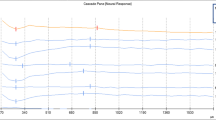Abstract
Purpose
To assess whether there is an interference of the spread of excitation (SOE) on speech recognition.
Methods
Retrospective cross-sectional study, approved by the institution’s ethics committee (CAAE03409212.8.0000.0068). Adult patients with intraoperative neural response telemetry (NRT) performed on electrodes 6, 11 and 16 implanted with Cochlear Ltd (Sydney, Australia) devices were selected. Patients with partial array insertion, pre-lingual hearing loss, deafness etiology due to and CI experience less than 12 months were excluded. SOE was recorded at 10 current units above the NRT threshold (tNRT) and its width in millimeters was collected at point 0.75 of the function. Speech recognition test was 25-recorded monosyllables list, presented at 65 dBHL at 0° azimuth in a sound treated booth. The analysis was divided into groups by electrode array type, regarding the tNRT, SOE width, SOE’s peak amplitude and electrode peak.
Results
A 126 SOE measurements of the 3 tested electrodes were obtained from 43 patients. Patients with straight array had significantly wider SOE, greater peak amplitude at electrode 6 and higher tNRTs. In the perimodiolar array, there was a negative correlation between SOE and monosyllables recognition at electrodes 6 and 11, and in the combined average of the three electrodes, with a significant difference in electrode 11. Sixty-six percent of the SOE measurements had their peak shifted to adjacent electrodes.
Conclusion
It was observed, in perimodiolar array, the greater the dispersion of electrical current, the worse the speech recognition, especially in the medial electrode.



Similar content being viewed by others
References
Abbas PJ, Hughes ML, Brown CJ, Miller CA, South H (2004) Channel interaction in cochlear implant users evaluated using the electrically evoked compound action potential. Audiol Neurootol 9(4):203–213
Hughes ML (2008) A re-evaluation of the relation between physiological channel interaction and electrode pitch ranking in cochlear implants. J Acoust Soc Am 124(5):2711–2714
Scheperle RA, Abbas PJ (2015) Relationships among peripheral and central electrophysiological measures of spatial and spectral selectivity and speech perception in cochlear implant users. Ear Hear 36(4):441–453
Grimm R, Pettinato M, Gillis S, Daelemans W (2019) Simulating speech processing with cochlear implants: How does channel interaction affect learning in neural networks? PLoS ONE 14(2):e0212134
van der Beek FB, Briaire JJ, Frijns JHM (2012) Effects of parameter manipulations on spread of excitation measured with electrically-evoked compound action potentials. Int J Audiol 51:465–474
He S, Teagle HFB, Buchman CA (2017) The electrically evoked compound action potential: from laboratory to clinic. Front Neurosci 11:339
Lee JY, Hong SH, Moon IJ, Kim EY, Baek E, Seol HY, Kang S (2019) Effect of cochlear implant electrode array design on electrophysiological and psychophysical measures: lateral wall versus perimodiolar types. J Audiol Otol. 23(3):145–152
Peters JPM, Bennink E, van Zanten GA (2019) Comparison of place-versus-pitch mismatch between a perimodiolar and lateral wall cochlear implant electrode array in patients with single-sided deafness and a cochlear implant. Audiol Neurootol 24(1):38–48
Ramos de Miguel Á, Durmo I, Falcón González JC, Borkoski Barreiro S, Ramos MA (2019) Evaluation of intracochlear position of a slim modiolar electrode array, by using different radiological analyses. Otol Neurotol 40(5S Suppl 1):S10–S17
Tsuji RK, Goffi-Gomez MVS, Orfila D, Cordero L, Orellano FR, Hocsman E, Bento RF (2019) Soft surgery with perimodiolar array impact on the spread of excitation. GICCA 2019, Pamplona
Nadol JB Jr, Young YS, Glynn RJ (1989) Survival of spiral ganglion cells in profound sensorineural hearing loss: implications for cochlear implantation. Ann Otol Rhinol Laryngol 98(6):411–467
Seyyedi M, Viana LM, Nadol JB Jr (2014) Within-subject comparison of word recognition and spiral ganglion cell count in bilateral cochlear implant recipients. Otol Neurotol 35(8):1446–1450
Acknowledgements
We are thankful to the otorhinolaryngology foundation and the support of the entire faculty and fellows of the cochlear implant program of the of the University of São Paulo Clinic Hospital
Author information
Authors and Affiliations
Corresponding author
Ethics declarations
Conflict of interest
We declare to have no conflict of interest with this study.
Additional information
Publisher's Note
Springer Nature remains neutral with regard to jurisdictional claims in published maps and institutional affiliations.
Rights and permissions
About this article
Cite this article
da Silva, J.C., Goffi-Gomez, M.V.S., Magalhães, A.T. et al. Is the spread of excitation width correlated to the speech recognition in cochlear implant users?. Eur Arch Otorhinolaryngol 278, 1815–1820 (2021). https://doi.org/10.1007/s00405-020-06260-9
Received:
Accepted:
Published:
Issue Date:
DOI: https://doi.org/10.1007/s00405-020-06260-9




